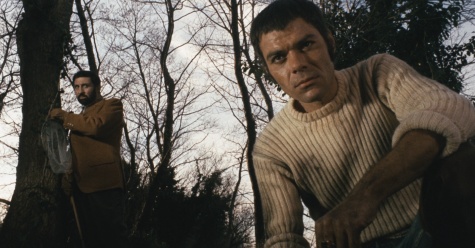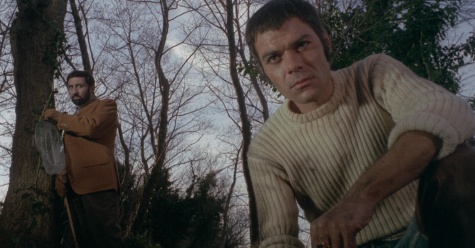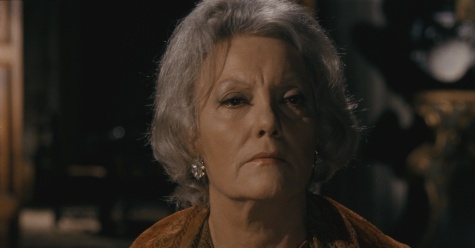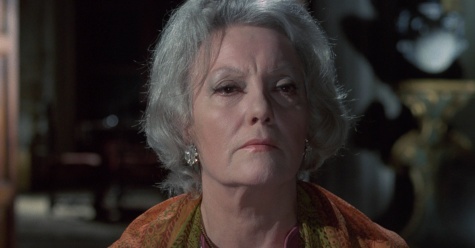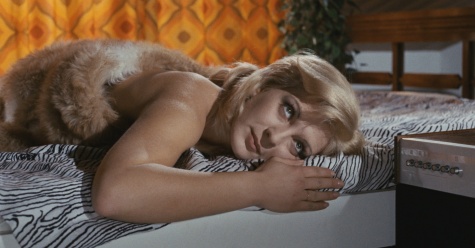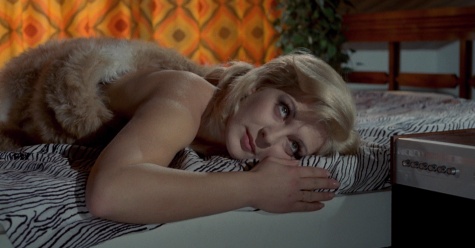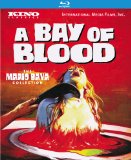| Reviews & Columns |
|
Reviews DVD TV on DVD Blu-ray 4K UHD International DVDs In Theaters Reviews by Studio Video Games Features Collector Series DVDs Easter Egg Database Interviews DVD Talk Radio Feature Articles Columns Anime Talk DVD Savant Horror DVDs The M.O.D. Squad Art House HD Talk Silent DVD
|
DVD Talk Forum |
|
|
| Resources |
|
DVD Price Search Customer Service #'s RCE Info Links |
|
Columns
|
|
|
Bay of Blood, A
Kino // R // September 3, 2013
List Price: $29.95 [Buy now and save at Amazon]
It doesn't matter what you call it, exactly: Blood Bath, Carnage, Twitch of the Death Nerve, Last House
on the Left Part 2, A Bay of Blood, or any of seemingly hundreds of other titles. This is a film that's gone largely unseen on these shores since its initial release more than forty years ago, and yet it still managed to define an entire subgenre and forever changed the face of horror. The first couple of Friday the 13th flicks ripped off Mario Bava's 1971 giallo wholesale, and without those, who knows if the slasher film would ever have carved a path of destruction in drive-ins and dingy theaters from one end of the country to the other?
A Bay of Blood opens as an elderly woman with all the right breeding navigates the halls of her impossibly lavish, palatial estate. As she passes through one of these corridors, a shadowy figure suddenly slips a noose around her neck. She struggles with every ounce of strength her frail form can muster, clawing and kicking furiously, but it's all for naught. As the wheelchair that was kicked out from under her continues spinning on the other side of the room, a woman we'd never properly met inevitably succumbs. The camera pans up, lingering briefly on the killer's black leather gloves. In any other giallo, the camera would stop at his shoulders, and the rest of the film would be some sort of blood-spattered whodunnit. A Bay of Blood instead keeps moving upwards, revealing the face of this well-dressed, middle-aged, and rather unremarkable looking killer. As our minds reel -- body count movies aren't allowed to do this! -- he's startled by a noise outside. After failing to find much of anything, the man returns to the scene of his grisly crime to leave a faked suicide note. As he looks down at his handiwork, a blade gleams in the moonlight and sinks into his back over and over and over and over again. He falls lifelessly to the floor, directly underneath the still-dangling corpse of the woman he'd coldly murdered a few short minutes earlier.
Though the structure of the slasher film would be shaped in large part by A Bay of Blood, its brilliant opening sequence immediately establishes that it's hardly some formulaic, forgettable, dead teenager flick. The conventions of gialli had barely been defined by 1971, and yet Mario Bava still defies most every last one of them,
resulting in a film that remains sharp and unpredictable more than four decades later. There isn't a Final Girl. Hell, you can't even divide A Bay of Blood's cast of characters into good guys and bad guys. Everyone on the bill is a self-serving asshole, from the gaggle of sex-crazed, twentysomething tourists to the small army of greedy bastards who'll do whatever it takes to seize control of this remote, sleepy, little lake town. Most slashers are spawned by some dark tragedy in the past; here, everyone's motivated by getting paid or getting laid. In the style of Agatha Christie's "Ten Little Indians", just about everyone throughout A Bay of Blood is capable of murder, and many of them get a chance to prove it.
Unlike the mostly offscreen kills in the previous year's Five Dolls for an August Moon, the baker's dozen of murders that Bava unleashes here are graphic, gruesome, and intense. The visceral make-up effects by future Academy Award winner Carlo Rambaldi still hold up startlingly well all these years later -- especially that double impaling! -- no matter how familiar these sequences may be after being parroted in the Friday the 13th series. Admittedly, the pace can be fairly sluggish early on. It's a borderline-eternity until the body count ticks upwards after the opening assaults, a couple of very length flashbacks greatly disrupt the flow, and such moments as the scenery-chewing psychic bickering with her entomologist husband feel like they drag on for hours. Though A Bay of Blood can get distracted by reams of dialogue, convoluted plotting, and searches for a hidden will and whatever else, it's not stingy with blades or billhooks. Its body count easily outclasses a lot of the slashers I've devoured over the years. None of the film's many imitators could possibly capture Bava's unparalleled eye for color and composition; this is a gorgeous, masterfully crafted film, not some mindless spam-in-a-cabin flick shat out in a week and a half. A Bay of Blood would be worth recommending for its historical value, if nothing else, laying the groundwork that would define horror and suspense throughout the early 1980s. Don't dismiss it as some hopelessly dated artifact, though; A Bay of Blood remains brutal, surprising, and unnervingly intense forty years later, ranking among the very best that the giallo or slasher genres ever produced. Highly Recommended.
Video
I'll confess to having been disappointed by the presentation on Arrow's Blu-ray release on the other side of the pond. Kino's disc, thankfully, addresses just about every last one of that British disc's shortcomings. I snapped a few screenshot comparisons, and they speak for themselves:
The lifeless colors and harsher contrast on the Arrow disc make way for something much more natural and well-balanced on these shores. One exception would be the opening titles, which are heavily windowboxed and boast more vivid blues and yellows on the Arrow disc, while the Kino titles are washed out and feel excessively cramped. The framing elsewhere is also slightly different; the Arrow disc tends to reveal more on the left side of the frame, while Kino's exposes an additional sliver to the right. Even apart from the titles, the opening sequence shifts things around somewhat dramatically as well, as you can see in the second set of comparisons. The two presentations are also matted somewhat differently; the aspect ratio on the Kino release is closer to 1.83:1 as opposed to Arrow's 1.89:1, revealing more at the top and bottom of the frame. The AVC encode on Kino's release leaves little room for complaint, and the skilled authoring shies away from excessive noise reduction, artificial edge enhancement, and the like. Even for those of us who imported A Bay of Blood from the UK a couple years back, Kino's Blu-ray release is an essential upgrade.
As A Bay of Blood is a double feature of sorts -- I'll get into that momentarily -- it hopefully goes without saying that this is a dual-layer disc.
Audio
This version of A Bay of Blood was shot with an English-speaking audience in mind, and its uncompressed audio is offered here in two-channel mono. Though not quite as remarkable sounding as some of Kino's other Bava releases have been, the LPCM soundtrack is still very much where it ought to be. Modest background noise is easily ignored. Dialogue does sound somewhat dated and suffers from occasional clipping, but it's not any more severe than you'd expect from most any genre film of this vintage. The only real oddity arrives around a third of the way into A Bay of Blood, with a couple of sequences sounding as if someone had stomped on a chorus pedal in the ADR booth. For whatever it's worth, I can't reproduce this strange effect on the Arrow disc or any versions of the film I've found streaming online. Other than that oddball modulation, this is a very respectable effort.
There are no subtitles or alternate language tracks, although the Italian version of the film is represented elsewhere on this disc.
Extras
Although the Kino release easily eclipses the Arrow disc in terms of presentation, it does lag very far behind when it comes to extras. Arrow serves up a poster, a collector's booklet, reversible cover art, the Italian version of A Bay of Blood, an audio commentary, a couple of trailers for the film (with Edgar Wright
commentary/introductions!), a pair of radio spots, and more than an hour of interviews and featurettes. The extras on the Kino release aren't anywhere near as extensive.
The Final Word
A Bay of Blood isn't just noteworthy as being the godfather of the '80s slasher subgenre; it's worth seeking out because it's an intense, endlessly surprising, and gruesome giallo in its own right. Kino has lavished A Bay of Blood with a startingly gorgeous presentation on Blu-ray. Though its extras aren't nearly as extensive as its counterpart across the pond, Tim Lucas' commentary and an alternate version of the film are still very strong selling points just the same. Bava fanatics may want to seek out both discs if they have multiregion capability -- Arrow's for the extras and Kino's for the presentation -- but if you have to choose one, Kino's release is the most Highly Recommended.
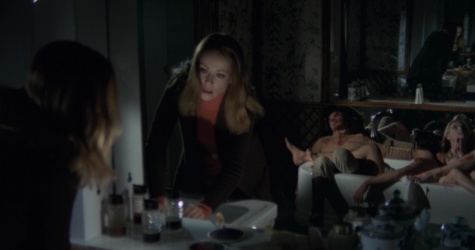 |
| [click on the thumbnail to enlarge] |
A Bay of Blood opens as an elderly woman with all the right breeding navigates the halls of her impossibly lavish, palatial estate. As she passes through one of these corridors, a shadowy figure suddenly slips a noose around her neck. She struggles with every ounce of strength her frail form can muster, clawing and kicking furiously, but it's all for naught. As the wheelchair that was kicked out from under her continues spinning on the other side of the room, a woman we'd never properly met inevitably succumbs. The camera pans up, lingering briefly on the killer's black leather gloves. In any other giallo, the camera would stop at his shoulders, and the rest of the film would be some sort of blood-spattered whodunnit. A Bay of Blood instead keeps moving upwards, revealing the face of this well-dressed, middle-aged, and rather unremarkable looking killer. As our minds reel -- body count movies aren't allowed to do this! -- he's startled by a noise outside. After failing to find much of anything, the man returns to the scene of his grisly crime to leave a faked suicide note. As he looks down at his handiwork, a blade gleams in the moonlight and sinks into his back over and over and over and over again. He falls lifelessly to the floor, directly underneath the still-dangling corpse of the woman he'd coldly murdered a few short minutes earlier.
Though the structure of the slasher film would be shaped in large part by A Bay of Blood, its brilliant opening sequence immediately establishes that it's hardly some formulaic, forgettable, dead teenager flick. The conventions of gialli had barely been defined by 1971, and yet Mario Bava still defies most every last one of them,
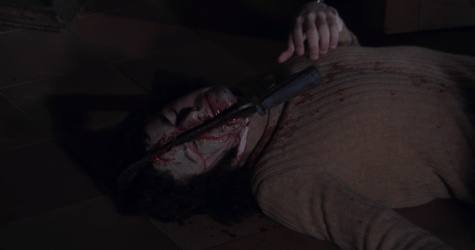 |
| [click on the thumbnail to enlarge] |
Unlike the mostly offscreen kills in the previous year's Five Dolls for an August Moon, the baker's dozen of murders that Bava unleashes here are graphic, gruesome, and intense. The visceral make-up effects by future Academy Award winner Carlo Rambaldi still hold up startlingly well all these years later -- especially that double impaling! -- no matter how familiar these sequences may be after being parroted in the Friday the 13th series. Admittedly, the pace can be fairly sluggish early on. It's a borderline-eternity until the body count ticks upwards after the opening assaults, a couple of very length flashbacks greatly disrupt the flow, and such moments as the scenery-chewing psychic bickering with her entomologist husband feel like they drag on for hours. Though A Bay of Blood can get distracted by reams of dialogue, convoluted plotting, and searches for a hidden will and whatever else, it's not stingy with blades or billhooks. Its body count easily outclasses a lot of the slashers I've devoured over the years. None of the film's many imitators could possibly capture Bava's unparalleled eye for color and composition; this is a gorgeous, masterfully crafted film, not some mindless spam-in-a-cabin flick shat out in a week and a half. A Bay of Blood would be worth recommending for its historical value, if nothing else, laying the groundwork that would define horror and suspense throughout the early 1980s. Don't dismiss it as some hopelessly dated artifact, though; A Bay of Blood remains brutal, surprising, and unnervingly intense forty years later, ranking among the very best that the giallo or slasher genres ever produced. Highly Recommended.
Video
I'll confess to having been disappointed by the presentation on Arrow's Blu-ray release on the other side of the pond. Kino's disc, thankfully, addresses just about every last one of that British disc's shortcomings. I snapped a few screenshot comparisons, and they speak for themselves:
The lifeless colors and harsher contrast on the Arrow disc make way for something much more natural and well-balanced on these shores. One exception would be the opening titles, which are heavily windowboxed and boast more vivid blues and yellows on the Arrow disc, while the Kino titles are washed out and feel excessively cramped. The framing elsewhere is also slightly different; the Arrow disc tends to reveal more on the left side of the frame, while Kino's exposes an additional sliver to the right. Even apart from the titles, the opening sequence shifts things around somewhat dramatically as well, as you can see in the second set of comparisons. The two presentations are also matted somewhat differently; the aspect ratio on the Kino release is closer to 1.83:1 as opposed to Arrow's 1.89:1, revealing more at the top and bottom of the frame. The AVC encode on Kino's release leaves little room for complaint, and the skilled authoring shies away from excessive noise reduction, artificial edge enhancement, and the like. Even for those of us who imported A Bay of Blood from the UK a couple years back, Kino's Blu-ray release is an essential upgrade.
As A Bay of Blood is a double feature of sorts -- I'll get into that momentarily -- it hopefully goes without saying that this is a dual-layer disc.
Audio
This version of A Bay of Blood was shot with an English-speaking audience in mind, and its uncompressed audio is offered here in two-channel mono. Though not quite as remarkable sounding as some of Kino's other Bava releases have been, the LPCM soundtrack is still very much where it ought to be. Modest background noise is easily ignored. Dialogue does sound somewhat dated and suffers from occasional clipping, but it's not any more severe than you'd expect from most any genre film of this vintage. The only real oddity arrives around a third of the way into A Bay of Blood, with a couple of sequences sounding as if someone had stomped on a chorus pedal in the ADR booth. For whatever it's worth, I can't reproduce this strange effect on the Arrow disc or any versions of the film I've found streaming online. Other than that oddball modulation, this is a very respectable effort.
There are no subtitles or alternate language tracks, although the Italian version of the film is represented elsewhere on this disc.
Extras
Although the Kino release easily eclipses the Arrow disc in terms of presentation, it does lag very far behind when it comes to extras. Arrow serves up a poster, a collector's booklet, reversible cover art, the Italian version of A Bay of Blood, an audio commentary, a couple of trailers for the film (with Edgar Wright
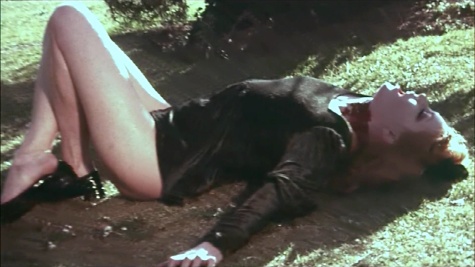 |
| The Italian version of A Bay of Blood [click on the thumbnail to enlarge] |
- Audio Commentary: This comprehensive, engaging, and very scholarly commentary by Tim Lucas (Mario Bava: All the Colors of the Dark) is the same track that appeared on the Arrow release. Among the innumerable highlights are how the casting of Isa Miranda presages what the original Friday the 13th accomplished with Betsy Palmer, Bava not being able to bring himself to kill an insect for a film with more than a dozen brutal murders, a spat between Dardano Sacchetti and Dario Argento over A Cat o' Nine Tails eventually spiraling into Sacchetti's screen credit here, and Christopher Lee generally finding himself repulsed by what his director in The Whip and the Body was up to in 1971. It's appropriate that A Bay of Blood hits store shelves the same day as Five Dolls for an August Moon, as Lucas draws a number of parallels between these two gialli and how Bava's approach to the subgenre changed so dramatically over the course of a year. If you haven't heard this commentary before now, it's well worth setting aside an hour and a half to give it a listen.
- A Bay of Blood (Italian) (85 min.; SD): As is noted in the disc's audio commentary, Mario Bava filmed scenes with dialogue twice: once in English and again in Italian. We're not talking about straightahead dubbing; these are entirely different takes, the editing is somewhat tighter, and the content of the dialogue has been changed in places. For instance, it's established in the Italian cut that the hornball tourists are partying in an abandoned nightclub; that's never made clear in the English version. The presentation is basically indistinguishable from the barely watchable one on the Arrow disc.
As it's been upconverted from an extremely low-quality source, it's little surprise that the Italian version is listed as an extra rather than a primary feature. It's a shame that there isn't a more robust source available to give this version of A Bay of Blood the proper 1080p remaster it deserves, but the inclusion of this alternate version of the film even in this dismal state is still very greatly appreciated. There's a screenshot to the right to give you a sense of what to expect, by the way. - Trailers (14 min.; SD): The only other extras are standard-def trailers for Black Sunday, A Bay of Blood, Baron Blood, Lisa and the Devil, and The House of Exorcism.
The Final Word
A Bay of Blood isn't just noteworthy as being the godfather of the '80s slasher subgenre; it's worth seeking out because it's an intense, endlessly surprising, and gruesome giallo in its own right. Kino has lavished A Bay of Blood with a startingly gorgeous presentation on Blu-ray. Though its extras aren't nearly as extensive as its counterpart across the pond, Tim Lucas' commentary and an alternate version of the film are still very strong selling points just the same. Bava fanatics may want to seek out both discs if they have multiregion capability -- Arrow's for the extras and Kino's for the presentation -- but if you have to choose one, Kino's release is the most Highly Recommended.
|
| Popular Reviews |
| Sponsored Links |
|
|
| Sponsored Links |
|
|
| Release List | Reviews | Shop | Newsletter | Forum | DVD Giveaways | Blu-Ray | Advertise |
|
Copyright 2024 DVDTalk.com All Rights Reserved. Legal Info, Privacy Policy, Terms of Use,
Manage Preferences,
Your Privacy Choices | |||||||









